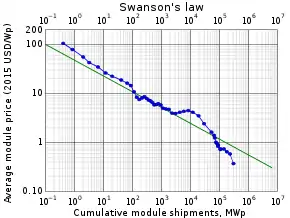Swanson's law
Swanson's law is the observation that the price of solar photovoltaic modules tends to drop 20 percent for every doubling of cumulative shipped volume. At present rates, costs go down 75% about every 10 years.[1] It is named after Richard Swanson, the founder of SunPower Corporation, a solar panel manufacturer.[2]

Swanson's law has been compared to Moore's law, which predicts the growing computing power of processors. Crystalline silicon photovoltaic cell prices have fallen from $76.67 per watt in 1977 to $0.36 per watt in 2014.[3][4][5] Plotting the module price (in $/Wp) versus time shows a dropping by 10% per year.[6]
The term Swanson's Law appears to have originated with an article in The Economist published in late 2012.[3][4] Swanson had been presenting such curves at technical conferences for several years.[7] It is a misnomer in that Swanson was not the first person to make this observation. The method used by Swanson is more commonly referred to as learning curve or experience curve analysis. It was first developed and applied to the aeronautics industry in 1936 by Theodore Paul Wright.[8] There are reports of it first being applied to the photovoltaics industry in 1975, and saw wider use starting in the early 1990s.[9]
References
- "Swanson's Law provides green ray of sunshine for PV". 2016-01-17.
- "Solar Cell Technology Solutions". SunPower Corporation. 2014-07-24. Note: Read more about current innovations in solar technology.
- Geoffrey Carr (2012-11-21). "Sunny Uplands: Alternative energy will no longer be alternative". The Economist. Retrieved 2012-12-28.
- Staff writer (2012-12-28). "Pricing Sunshine". The Economist. Retrieved 2012-12-28.
- R. M. Swanson (2006). "A vision for crystalline silicon photovoltaics". Progress in Photovoltaics: Research and Applications. 14 (5): 443–453. doi:10.1002/pip.709.
- J. Doyne Farmer; François Lafond (2 November 2015). "How predictable is technological progress?". Research Policy. 45 (3): 647–665. arXiv:1502.05274. doi:10.1016/j.respol.2015.11.001. License: cc. Note: Appendix F. A trend extrapolation of solar energy capacity.
- "13th Workshop on Crystalline Silicon Solar Cell Materials and Processes" (PDF). January 2004.
- T. P. Wright (1936). "Factors affecting the costs of airplanes". Journal of the Aeronautical Sciences. 3 (4): 122–128. doi:10.2514/8.155.
- A. de la Tour; M. Glachant; Y. Ménière (2013). "What Cost for Photovoltaic Modules in 2020? Lessons from Experience Curve Models". Interdisciplinary Institute for Innovation. Retrieved 2020-09-08.